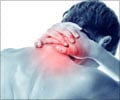Glossary
Dizziness: Feeling faint or unsteady.Ligaments: Fibrous, slightly elastic band of tissue that which connects the ends of bones and prevents excessive movement of the joint, or holds organs in place.
Headache: Pain or discomfort of the head, upper face, scalp, or neck region
Fatigue: Feeling weak.
Anxiety: Feeling tensed.
Depression: Mental state of low mood commonly associated with feelings of sadness, emptiness, despair or loss of interest in life or worldly matters.
Frustration: Feeling upset or annoyed
X Ray: High energy radiation with waves shorter than those of visible light. X-rays possess the properties of penetrating most substances (to varying extents), of acting on a photographic film or plate (permitting radiography), and of causing a fluorescent screen to give off light (permitting fluoroscopy). In low doses X-rays are used for making images that help to diagnose disease, and in high doses to treat cancer. Formerly called a Roentgen ray.
MRI: A painless method using magnetic fields for taking pictures of internal organs.
CT: This is a X- ray procedure enhanced by computer the results are three dimensioned scan through a body part showing bone and body tissue.
Orthopedics: Orthopedics is a branch of medicine, which is related to diagnosis and treatment of diseases of Musculo- skeletal system.
Seizures: Convulsions; sudden, involuntary movements of the muscles.
Rash: Rash is a red like spot that spread over the skin
Tumors: A pathological tissue growth, characterized by uncontrolled multiplication of cells.
Cerebrospinal fluid: The watery fluid that fills the spaces in and around the brain and spinal cord.
Sarcoidosis: Sarcoidosis is an idiopathic immune system disorder that causes tissue inflammation and affects many body organs.
Autoimmune diseases: When the immune system mistakes self tissues (self antigens) as foreign antigen (non self) and results in an inappropriate immune response it results in an autoimmune disease.
Osteophytes: Abnormal bony outgrowths in the surface of osteoarthritic joint
Trauma: An injury (as a wound) to living tissue caused by an extrinsic agent.
Heart attack: Descriptive term for a myocardial infarction: a painful, and sometimes fatal, incident caused by the blockage of one or more of the coronary arteries resulting in interruption of blood flow to a part of the heart.
Physiotherapist: A health professional trained in the use of treatments such as exercise and massage.
Fracture: A fracture is a break in the bone or cartilage. Fractures are also named by the trauma event that caused the bone breakage.
Meningitis: Meningitis is the infection and inflammation of the meninges (lining around the brain and spinal cord), and sometimes the cerebrospinal fluid, or CSF that surrounds the brain and spinal cord.







